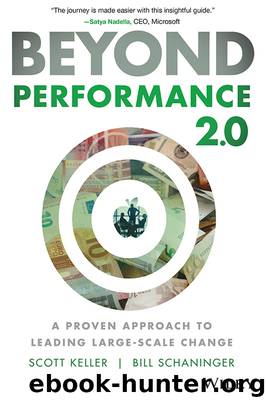Beyond Performance 2.0 by Scott Keller & Bill Schaninger

Author:Scott Keller & Bill Schaninger
Language: eng
Format: epub
ISBN: 9781119596660
Publisher: Wiley
Published: 2019-05-29T14:00:00+00:00
Understanding and Conviction
The work of Stanford social psychologist Leon Festinger demonstrates the need people have to align their actions with their beliefs. Half a century ago, Festinger proposed the theory of “cognitive dissonance”: that individuals seek consistency among their thoughts, opinions, and beliefs (or cognitions) and their behaviors, and try to eliminate any inconsistencies or dissonance between them. Festinger noted, “It’s difficult to behave in a different way if the behavior is inconsistent with your view of the world.”14
The implication of this finding for a change leader is that if employees don’t believe in the overall purpose of the change, they will suffer cognitive dissonance when asked to support it. If they do believe in it, on the other hand, they will be inclined to change their behavior to serve that purpose. Therefore, it’s imperative for anyone leading a major change program to take the time to think through the “change story”—what makes it worth undertaking—and what is the role of the individual’s actions in its unfolding that makes it worthwhile to play a part.
The advantage of a story—as opposed to a report or an analysis—is that it can convey emotions as well as facts. We therefore respond to it in a different way; we don’t just process the information intellectually, we relate it to our personal experiences and beliefs. According to our survey, programs that communicate and embed an emotionally compelling narrative about the desired change are 3.8 times more likely to succeed than those that don’t.15 Further, when change leaders are asked what they would have done differently in retrospect, the number one vote-getter is “spending more time developing and communicating the change story,” cited by 44 percent of change leaders.16
In this section, we’ll focus our discussion on the content needed for a great change story, but that won’t be the whole story. We’ll expand on this when we talk later in this chapter about interactively cascading the story (and why a traditional cascade never works). We’ll then talk about how to maximize the meaning quotient of the story when we get to this chapter’s “Master Stroke.” Then, in Chapter 6, we’ll talk further about how to keep the narrative alive through on-going two-way communications. It’s simply that important!
It’s important to keep in mind that if the leader doesn’t provide a story, employees will create their own. For instance, an innocent comment from a leader about the need to be more cost-conscious can spark near-hysteria as it spreads through an organization. Before long, it can turn into a story like, “All the work in our division is going to be outsourced and we’re all about to lose our jobs.” Sounds far-fetched? It’s not—we’ve seen it happen. Had the comment been placed in the context of a robust change story, this kind of misunderstanding would never have arisen.
So let’s get to the content needed. Good change stories use concrete, evocative, and immediate language to answer employees’ fundamental questions: Where are we today? Why do we have to change? What
Download
This site does not store any files on its server. We only index and link to content provided by other sites. Please contact the content providers to delete copyright contents if any and email us, we'll remove relevant links or contents immediately.
Bad Blood by John Carreyrou(6558)
Rich Dad Poor Dad by Robert T. Kiyosaki(6414)
Principles: Life and Work by Ray Dalio(6226)
Playing to Win_ How Strategy Really Works by A.G. Lafley & Roger L. Martin(5937)
Management Strategies for the Cloud Revolution: How Cloud Computing Is Transforming Business and Why You Can't Afford to Be Left Behind by Charles Babcock(4528)
The Confidence Code by Katty Kay(4190)
Thinking in Bets by Annie Duke(4154)
American Kingpin by Nick Bilton(3760)
Delivering Happiness by Tony Hsieh(3369)
Project Animal Farm: An Accidental Journey into the Secret World of Farming and the Truth About Our Food by Sonia Faruqi(3178)
The Power of Habit by Charles Duhigg(3063)
The Tyranny of Metrics by Jerry Z. Muller(3005)
Brotopia by Emily Chang(3002)
Mastering Bitcoin: Programming the Open Blockchain by Andreas M. Antonopoulos(2983)
The Marketing Plan Handbook: Develop Big-Picture Marketing Plans for Pennies on the Dollar by Robert W. Bly(2978)
I Live in the Future & Here's How It Works by Nick Bilton(2938)
The Content Trap by Bharat Anand(2863)
Building a StoryBrand by Donald Miller(2843)
Applied Empathy by Michael Ventura(2839)
